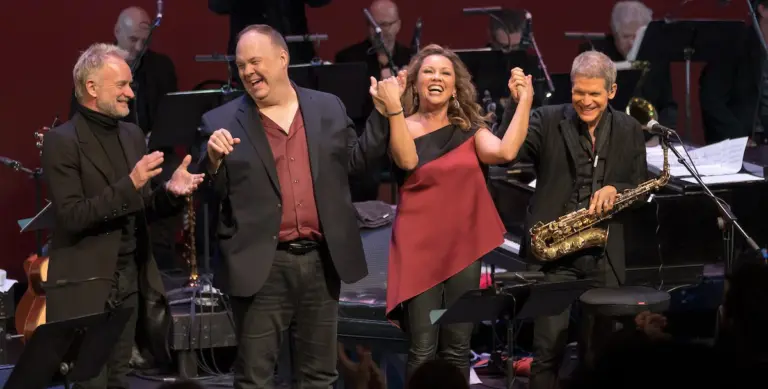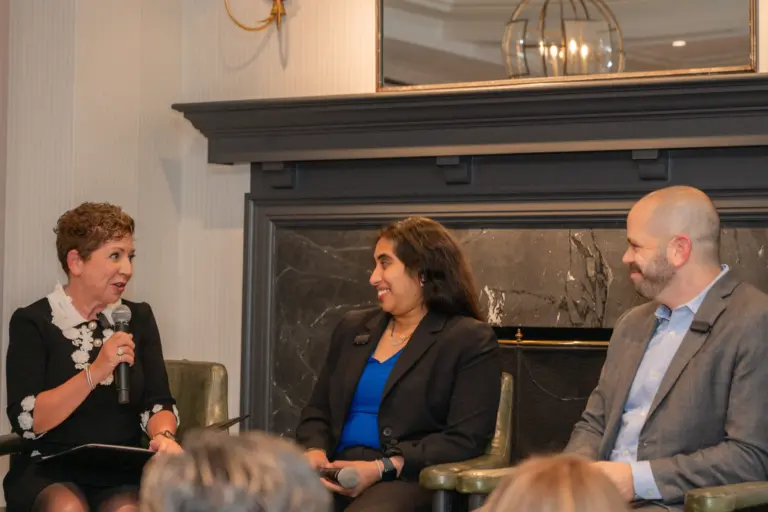By James Dean
At the September 6 meeting of the Greenwich Retired Men’s Association, George Ubogy introduced his wife, Jo Ubogy, who spoke on the Monarch butterfly and her experience in creating habitats and raising butterflies. George introduced the talk by playing beautiful renditions of excerpts from Puccini’s Madama Butterfly and a Schumann piano piece to set the mood for the talk.
Jo then spoke, describing herself as an “autodidact’, or self-taught naturalist. By profession she is a trained sculptor who worked in welding steel into art. When she was no longer able to do the welding, she turned to graphic digital art and has most recently been experimenting with AI assisted art. Jo shared beautiful photos of her gardens, sculptures, and butterflies in all their stages of metamorphosis. She utilized her photos to explain the life cycle of the Monarch butterfly which goes through four stages: egg, larva, pupa/chrysalis, and adult. The adult Eastern Monarch butterfly completes a two-way migration from its Eastern habitats to the Sierra Madre mountains in Mexico. This is an extraordinary migration by what is called the “Methuselah” generation of the adult butterfly.
Jo spoke of the danger to the existence of the Monarch which she perceives to be the “canary in the coal mine” warning us of the effects of logging and land development as well as climate changes leading to the loss of their natural habitat. To help maintain the butterfly Jo and George gather and raise monarch eggs which are found on the underside of milkweed leaves. Jo explained the process which involves placing the eggs in mesh enclosures with adequate milkweed plants to feed the caterpillar. When they hatch, the butterflies are quite voracious and can strip a plant as they grow. Jo noted that in her southern home in Sarasota the climate favors growth of a parasite that destroys the butterfly; (Ophryocystis elektroscirrha [OE] is a debilitating protozoan parasite that infects monarchs. Infected adult monarchs harbor thousands or millions of microscopic OE spores on the outside of their bodies). Our cold northeast climate prevents this parasite from thriving. Jo encourages the audience to be aware of the butterflies and to consider planting their own butterfly gardens.
Connecticut has a not-for-profit group called the Pollinator Pathways Project (https://www.pollinator-pathway.org/about). Begun in 2017, the goal is to establish pollinator-friendly habitat and food sources for bees, butterflies, hummingbirds, and other pollinating insects and wildlife along a series of continuous corridors, a global plan to connect protected conservation land with pollinator-friendly trees, shrubs, and perennials, literally creating pollinator pathways. Private citizens, municipalities and businesses could all be part of the solution by agreeing to plant native species and avoid pesticides. This would provide migrating pollinators with a place to rest, feed and reproduce. Call 1-833-233-6648 (1-833-BEE ONIT) for information.
To see the full presentation, go to https://greenwichrma.org, cursor to “Speakers” and click on “Speaker Videos.”
On September 20, Steve Kemper will give a talk to the Retired Men’s Association of Greenwich, based on his recent book, Our Man in Tokyo: an American Ambassador and the Countdown to Pearl Harbor. The book chronicles the experiences of Ambassador Joseph C. Grew in Japan during the turbulent decade that culminated with the surprise attack on the U. S. fleet. Grew spent that decade attempting to warn American leaders about the risks of Japan’s raging nationalism and ambitious militarism, while also trying to stabilize Tokyo’s increasingly erratic and belligerent foreign policy. His dispatches and counsel from the darkening heart of the Japanese empire were prescient, but often disregarded in Washington. The story is less well-known than the rise of Nazism and fascism in Europe, but no less compelling. Kemper reconstructs a dramatic backstage view of these explosive years by drawing on Grew’s 6,000-page Tokyo diary, thousands of diplomatic dispatches between the embassy and the State Department, and firsthand Japanese accounts to take readers into the Tokyo embassy, the Japanese cabinet, and the imperial palace. His talk will likewise bring this era to life, with help from historical images.
Kemper is also the author of A Splendid Savage: the Restless Life of Frederick Russell Burnham; A Labyrinth of Kingdoms: 10,000 Miles Through Islamic Africa; and Code Name Ginger: the Story Behind Segway and Dean Kamen’s Quest to Invent a New World. His work has appeared in many national magazines and newspapers. He lives in West Hartford. More information at www.stevekemper.net.
To stream the presentation on September 20, click on https://bit.ly/301Bj21. This presentation will also be available on local public access TV channels, Verizon FIOS channel 24 and Optimum (Cablevision) channel 79.
Note: The views expressed in these presentations are those of the speakers. They are not intended to represent the views of the RMA or its members.
RMA speaker presentations are presented as a community service at no cost to attendees, regardless of gender. The RMA urges all eligible individuals to consider becoming a member of our great organization, and thereby enjoy all the available fellowship, volunteer, and community service opportunities which the RMA offers to its members. For further information, go to https://greenwichrma.org/, or contact our membership chairman (mailto:members@greenwichrma.org).




